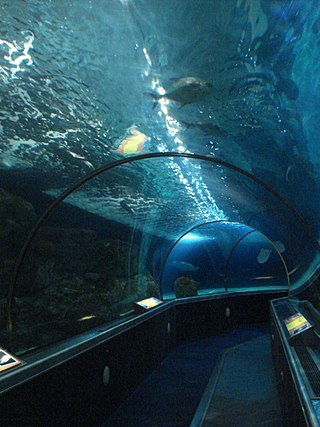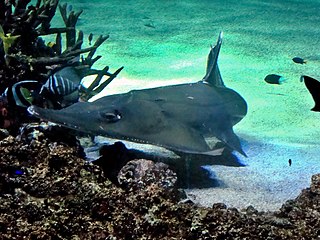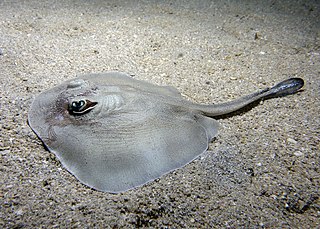
The guitarfish, also referred to as shovelnose rays, are a family, Rhinobatidae, of rays. The guitarfish are known for an elongated body with a flattened head and trunk and small, ray-like wings. The combined range of the various species is tropical, subtropical, and warm temperate waters worldwide.

The shovelnose guitarfish, Pseudobatos productus, is a ray in the family Rhinobatidae. It becomes mature at an estimated seven to eight years old. Males are between 90–100 cm (35–39 in) long, while females are around 99 cm (39 in) at that age. The ray can live up to 11 years, and full-grown sizes are around 120 cm (47 in) for males, and females reach 137 cm (54 in). They range from central California south to the Gulf of California. Morphological and genetic variations occur in the mitochondrial DNA in those found in the Gulf of California, evidencing their isolation from the rest. Because of this, the conservation of this species must be carefully managed to preserve the biological diversity. The shovelnose is considered to be a primitively developed ray, with many features of both sharks and rays.

Sea Life at Mall of America is a public aquarium located in the Mall of America in Bloomington, Minnesota, United States. The 1.3 million-US-gallon aquarium contains thousands of aquatic creatures, including sea turtles, sharks, sawfish, stingrays, jellyfish and seahorses. There are eleven exhibits featured at the aquarium.

The shovelnose sturgeon is the smallest species of freshwater sturgeon native to North America. It is often called hackleback, sand sturgeon, or switchtail. Switchtail refers to the long filament found on the upper lobe of the caudal fin. Shovelnose sturgeon are the most abundant sturgeon found in the Missouri River and Mississippi River systems, and were formerly a commercially fished sturgeon in the United States of America. In 2010, they were listed as threatened under the U.S. Endangered Species Act due to their resemblance to the endangered pallid sturgeon, with which shovelnose sturgeon are sympatric.

The shovelnose salamander is a species of salamander in the family Plethodontidae. It is endemic to the United States.

The spotted shovelnose ray is a species of fish in the Rhinobatidae family. It is endemic to northern Australia. Its natural habitat is open seas.

Aptychotrema is a genus of guitarfish, belonging to the family Rhinobatidae. They are found around Australia.

Rhinobatos is a genus of fish in the Rhinobatidae family. Although previously used to encompass all guitarfishes, it was found to be polyphyletic, and recent authorities have transferred many species included in the genus to Acroteriobatus, Glaucostegus, and Pseudobatos.
The bareback shovelnose ray or nakedback guitarfish, is a species of fish in the Rhinobatidae family. It is found in Seychelles and Mauritius. Its natural habitat is open seas.

The goldeneye shovelnose ray is a species of fish in the Rhinobatidae family. It is endemic to north-western Australia. Its natural habitat is open seas.

The common shovelnose ray, giant shovelnose ray or giant guitarfish is a species of fish in the Rhinobatidae family found in the central Indo-Pacific, ranging from India to the East China Sea, Solomon Islands and northern Australia. It is found in shallow coastal areas to a depth of at least 100 m (330 ft), including mangrove, estuaries and reportedly also in freshwaters. It reaches up to 2.7 m (8.9 ft) in length, and is greyish-brown to yellowish-brown above with a paler snout.

Rhynchobatus australiae, also called the white-spotted guitarfish, white-spotted wedgefish or bottlenose wedgefish, is a species of fish in the Rhinidae family. It is found from shallow waters to a depth of at least 60 m (200 ft) in the Indo-Pacific, ranging from the East African coast and the Red Sea, to Taiwan, the Philippines and Australia. It is part of a species complex that also includes the giant guitarfish, the broadnose wedgefish and possibly the smoothnose wedgefish.

The western shovelnose stingaree is a common species of stingray in the family Urolophidae, inhabiting shallow sandy flats and seagrass beds off southwestern Australia from Perth to Gulf St Vincent. Growing to 37 cm (15 in) long, this small ray has a rounded pectoral fin disc and a blunt, broadly triangular snout. Its nostrils have enlarged lobes along the outer rims and a skirt-shaped curtain of skin between them with a strongly fringed posterior margin. Its tail ends in a lance-like caudal fin and lacks dorsal fins and lateral skin folds. This species is colored grayish to brownish above, sometimes with lighter and darker spots, and pale below, sometimes with darker marginal bands and blotches.
The yellow shovelnose stingaree is a little-known species of stingray in the family Urolophidae, endemic to the outer continental shelf off Western Australia at a depth of 100–210 m (330–690 ft). Growing to 39 cm (15 in) long, this species has an oval pectoral fin disc with a rather elongated, triangular snout, and a short tail with a caudal fin but no dorsal fin. There are prominent lobes outside of its nostrils, and a skirt-shaped flap of skin with a deeply fringed trailing margin in between. Above, this ray is an almost completely uniform light to dark yellow color, which darkens on the caudal fin. The International Union for Conservation of Nature (IUCN) assesses the yellow shovelnose stingaree as least concern, as there is minimal fishing within its range.

The eastern shovelnose stingaree is a species of stingray in the family Urolophidae, endemic to coastal waters off southeastern Australia, excluding Tasmania. This species has a rounded pectoral fin disc wider than long, a fleshy snout forming an obtuse angle, and a relatively short tail terminating in a caudal fin. Its nostrils have prominent lobes on their outside rims and a skirt-shaped curtain of skin with a strongly fringed trailing margin between them. The dorsal coloration is mostly plain brownish, occasionally with a scattering of darker and/or lighter spots. One of the larger stingarees, it can grow to at least 80 cm (31 in) long.

The dwarf sturgeon, little shovelnose sturgeon, or small Amu-Darya shovelnose sturgeon is a species of fish in the family Acipenseridae. It is found in Turkmenistan, Uzbekistan and probably in Tajikistan.

The Amu Darya sturgeon or false shovelnose sturgeon is a critically endangered species of fish in the family Acipenseridae. It is found in Turkmenistan, Uzbekistan, Tajikistan and perhaps Afghanistan. It inhabits quite shallow flowing waters that are turbid and muddy.

Narcine entemedor, the giant electric ray or Cortez electric ray, is a species of numbfish, family Narcinidae, native to the eastern Pacific Ocean from the Gulf of California to Panama. It is found in shallow water on sandy bottoms and sometimes adjacent to reefs. This species is closely related to the lesser electric ray from the western Atlantic, and may represent the same species. The specific epithet entemedor seems to be the Spanish equivalent of "intimidator".

The eastern shovelnose ray is a species of guitarfish in the family Rhinobatidae of order Rhinopristiformes. The species is endemic to the east coast of Australia and inhabits subtropical and temperate waters from southern Queensland to southern New South Wales.

Trygonorrhinidae, the banjo rays, is a family of rays, comprising eight species in three genera. They were formerly classified in the family Rhinobatidae.

















